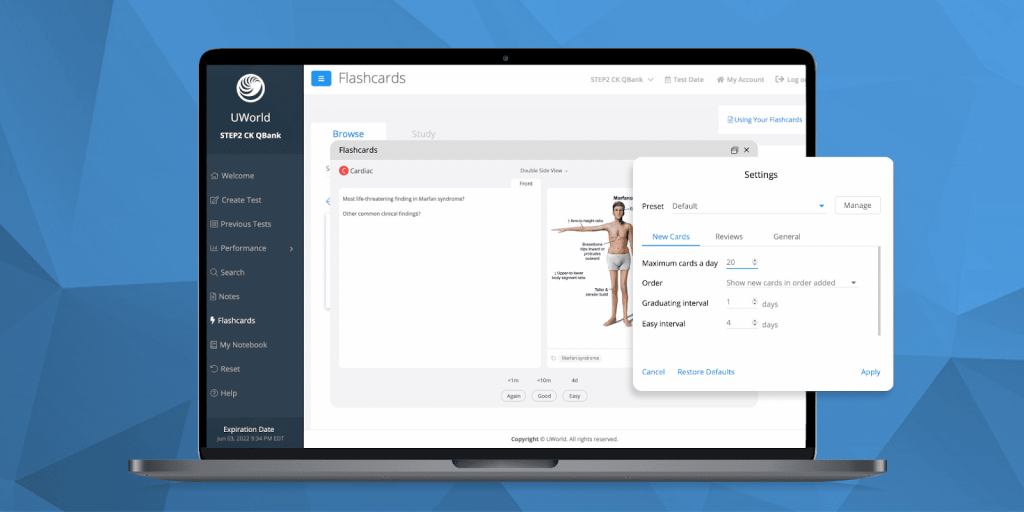by Eric Grisham, MD & Anup Bhattacharya, MD
Step 1 is done, and you’re immersed in your clinical rotations. You’re starting to get the hang of shelf exams, but now it’s time to plan for your upcoming USMLE® Step 2 CK exam! Especially with Step 1 becoming pass/fail, doing well on Step 2 CK is more critical than ever. Given the higher stakes, you might be wondering: “What’s the best way to achieve a great score on Step 2?”
As with Step 1, you’ll need a solid foundation from your pre-clinical and clinical studies to succeed, as well as an intentional approach to mastering Step 2 CK material that involves active learning (like taking practice questions in a QBank) and effective memory tools (like flashcards). Together, these strategies have a great track record of helping students remember and apply all the information they need to achieve a high score.
Remembering More: Spaced Repetition
This is where the concept of spaced repetition typically enters the conversation. Spaced repetition is an active learning technique that involves taking information you need to memorize, usually in the form of flashcards, and repeating it across increasing intervals to help improve memory retention. With spaced repetition, you systematically introduce new content and review old content according to the strength of your recall and understanding. Material with weak recall is reviewed at frequent intervals; material with strong recall is still reviewed but less frequently. As you become more familiar with the content, the intervals are spaced out within the review rotation according to this weak/strong interval scheme.
Think of this as building your “muscle memory” for USMLE Step 2 CK facts. As your muscle memory (or content recall) strengthens in a particular area, you can afford to practice it a little bit less and focus on other material. This is important because the brain, while astounding in its capability and function, can only remember so much before it forgets things that once seemed familiar. Even information reviewed just yesterday (like that block of UWorld questions that seemed crystal clear) can be quickly forgotten without strategic material review. There is often a discrepancy between our perceived retention of material and our actual retention of material: we think we remember more than we actually do.
So what can we do to actually remember more? Spaced repetition.
Spaced Repetition and the USMLE Step 2 CK
In the past, conversations about spaced repetition were typically centered around Anki flashcards, since Anki was one of the first platforms to integrate spaced repetition technology. But, recently, UWorld incorporated spaced repetition into their Flashcards! As part of the Flashcards section of the UWorld Step 2 CK Qbank, there is now a “Study” mode that integrates spaced repetition.
This means that, while going through UWorld question blocks, you can conveniently create flashcards using pictures, tables, and critical information from each question. And then you can study any of that UWorld content with spaced repetition without ever leaving the learning platform.
Some students may still want to use Anki in tandem with UWorld’s flashcards. While both platforms give students the ability to create custom flashcards (and UWorld allows you to easily copy any of its proprietary images or tables onto your flashcards), some students like to use Anki premade decks. For those who are interested in this option, the most comprehensive Anki deck for USMLE Step 2 CK studying is the AnKing Step 2 CK Anki deck, which combines the best parts of the Dorian and Zanki Step 2 and merges with the AnKing Step 1 deck.
As you’re making and using your flashcard decks, keep in mind the balance between being comprehensive and being realistic–that way you don’t end up with too few or too manyflashcards. If you have too few, not only will you not be learning enough of the high-yield concepts for your exam, but there won’t be enough variety for spaced repetition integrations to function properly. On the other hand, if you make too many cards, you won’t have enough time to focus your attention on the most important concepts, and you may struggle getting through everything you need to review in a given day. One way to prevent the “too-many-cards” scenario is to make only one card for each UWorld question; this forces you to identify the concepts or details that are both high yield and unfamiliar to you.
A Final Word about Studying for Step 2 CK
It can be easy to forget that one of the best ways to study for Step 2 CK is to study well for your shelf exams. As you’ll discover during your clinical rotations, time is a precious resource given the competing needs to perform clinical duties and study for shelf exams. Fortunately, using flashcards as a supplement to UWorld’s Shelf Review during your clinical rotations is both an excellent and efficient way to simultaneously study for your shelf exams and Step 2 CK! For example, you can keep up with surgical content through your flashcards even during clinical rotations; this will keep the information fresh for CK months following your surgery shelf exam. There’s no need to reinvent the wheel here—the same study methods that served you well for Step 1 study can be effectively applied to Step 2 CK.
That’s everything you need to know about spaced repetition for Step 2 CK! If you have any more questions about the UWorld’s features—Flashcards or otherwise—you can check out the UWorld Medical Blog, which is continually updated with helpful tips and tricks for maximizing your study experience. Happy studying!
